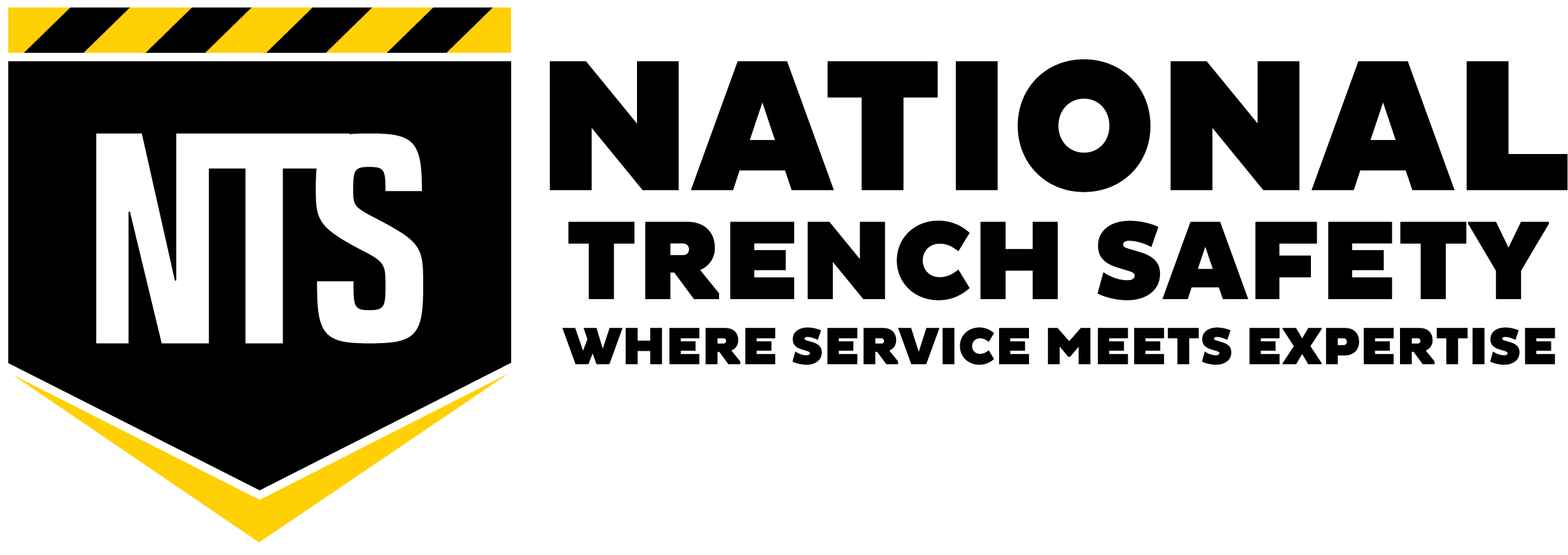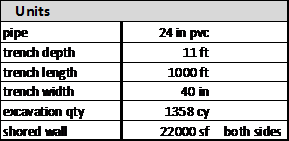At National Trench Safety we are in the process of developing useful shoring cost estimating information for construction managers and estimators. In the process, I am developing a series of articles about the estimating process.
Construction cost estimating can easily be broken down in a systematic way. Everything that goes into building anything can be broken down into three basic components: the cost of labor, the cost of equipment, and the cost of materials. These are considered hard costs and soft costs, such as risk assessment, field overhead, office overhead, and profit, are usually based on the results of the hard cost estimate. Each category has some unique properties and variables:
- Labor can vary with the wage rate and the productivity rate. Wage rates are easy to pin down since they are published for most trades. The rate used in an estimate can be easily factored to reflect the current rates and variations in regions. Productivity is far more elusive as work rules, a worker’s experience with the task, crew size, and the proper feed of materials and equipment all influence the production rate.
- Equipment cost varies with time on rent, and whether it is owned or rented. Construction equipment owned by the contractor can be discounted to the point where only fuel and maintenance are charged. Owned equipment can be set on a job and only charged for the time it is being used while rental equipment is charged based on the period of time it is on rent. For any piece of equipment, there are costs associated with owning it. Inevitably equipment has to be purchased, financed, yarded when not in use, maintained when in use, scrapped, salvaged, or traded in for newer versions over time. When a contractor owns his own equipment he is limited by what his specific equipment can do while a contractor that rents equipment can choose equipment that is specifically designed for the particular task at hand and exchange it for something else more appropriate when he takes on a different job. Equipment management is a complicated business so the decision to own or rent can be complicated. Figuring out how to build construction projects and how to best manage equipment are two different endeavors. The trend is to own and manage equipment common to all projects like trucks and small tractors and to rent specialty equipment like cranes and shoring equipment.
- Materials are easy to quantify and price. The hard part of materials estimates and what can be easily forgotten is the cost of acquiring, shipping, storing, and delivering them to the production location. How much sand and gravel is wasted versus what is needed to bed and backfill the pipe, quality, and specification adherence, theft and waste, trucking, and staging at the site all need to be included in the cost of the materials, not just the unit price.
A construction cost estimate starts with a quantity survey or take-off. This is simply a breakdown of quantifiable elements of the project. Figure 1 gives some typical elements and units.
After the quantity survey is completed labor equipment and material prices are gathered. A portion of a pipeline project quantity survey might look like this:
Equipment pricing for this project would look like this:
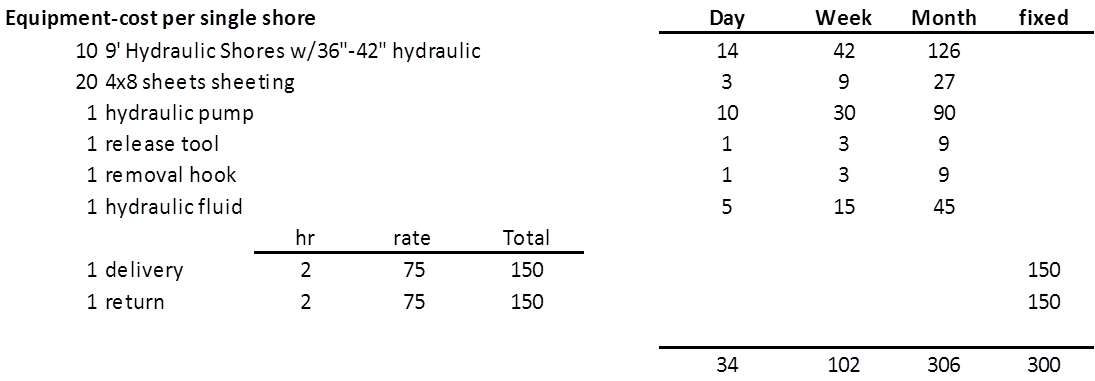 Labor and handling pricing for shoring installation might look like this:
Labor and handling pricing for shoring installation might look like this:
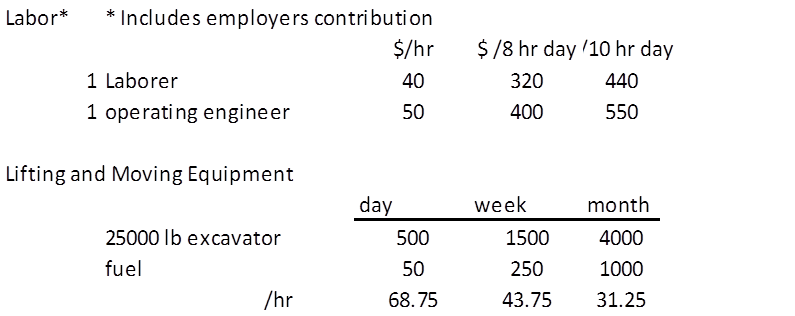
Productivity rates are then developed. The best source of productivity rates is the contractor’s previous experience with similar types of work, also time studies, or guesses are used. The following is a production estimate for installing hydraulic shores.
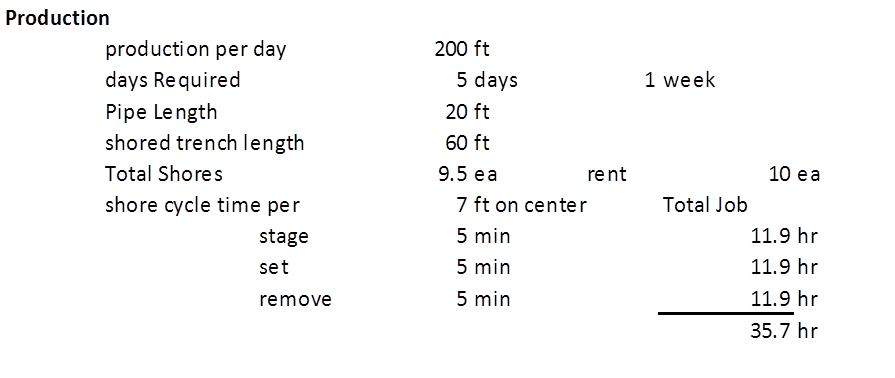
At the end of the process, the final labor, equipment, and material (LEM) estimate is run.
 By breaking the cost down in this way each element can be looked at separately. This estimate shows that the labor cost is almost two times the equipment cost and there is no material cost associated with the operation. If the contractor owned his own excavator the risk on his equipment cost would be limited to the cost of the shoring rental while the risk on labor is very high. At the bottom line of the bid, the contractor generally looks at the total of LEM and assesses the percentage of risk and profit accordingly by marking the labor higher than the equipment and the material the least because he may own some of the equipment and is fairly certain about what he will spend on materials.
By breaking the cost down in this way each element can be looked at separately. This estimate shows that the labor cost is almost two times the equipment cost and there is no material cost associated with the operation. If the contractor owned his own excavator the risk on his equipment cost would be limited to the cost of the shoring rental while the risk on labor is very high. At the bottom line of the bid, the contractor generally looks at the total of LEM and assesses the percentage of risk and profit accordingly by marking the labor higher than the equipment and the material the least because he may own some of the equipment and is fairly certain about what he will spend on materials.
At the end of the project, the thorough contractor goes back and looks at how well he did on the project. Whether he made money or lost money the numbers are important to future projects and the success of his company. From the cost survey above a unit price summary can be developed.
Unit pricing is extremely valuable when bidding work; however, it is extremely important to understand the underlying elements of the units. The fact is that most of the work bid is based on unit prices that came from other places than the contractor’s experience. These prices come from many places such as the unit prices put forward in the bidding document results, estimating manuals, highway department bid results, and even the back of napkins at a bar that was developed the day before the bid. It all works as long as the contractor has a good understanding of where the numbers came from. Surveys tell us that, all else being constant, if a bid result is within 10% of another bid on the same project it is about as can be expected. This means that if a contractor bid $9,000,000 and the next contractor bid $10,000,000 he is just as likely to make his expected profit as the other contractor based on these surveys.
The numbers used in this example are for illustration purposes only and should not be relied upon.
DISCLAIMER: the information contained in this article is provided for general and illustrative purposes only and is not to be considered Site Specific and or designated engineering for any project or work zone, nor is it to be used or considered to be tabulated data, technical data, advice and or counsel to be used on any job site. Each project is different and is the responsibility of the employer’s designated Competent Person to make decisions on what systems and methods may be used in compliance with federal and local regulations, manufacturers tabulated data, engineered drawings, and other plans.
